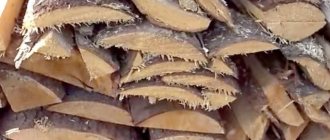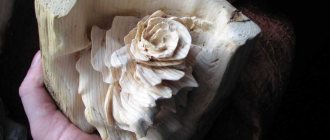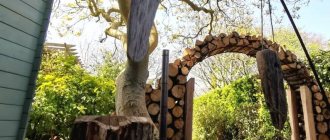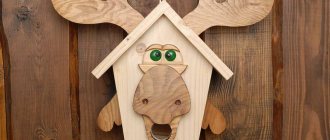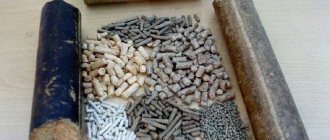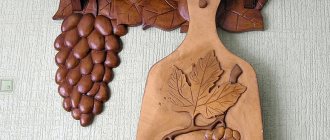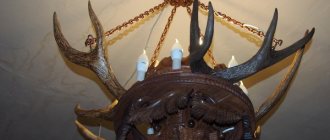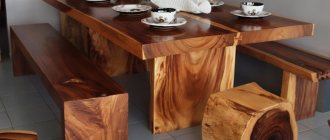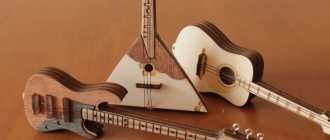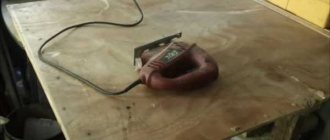Croakers are parts of wood that are waste from lumber production. Croakers are divided into commercial and wood-burning.
A small wood slab is suitable for fuel chips. No further benefit can be derived from this species, as it is heterogeneous and has defects.
Business croaker is often used for agricultural and construction purposes. It is much larger, thicker and wider than a wood-burning one, and it has almost no defects.
Compared to boards, logs or beams, slabs have a large number of advantages. It is inexpensive, can be used almost anywhere you need to build something, and is lightweight. You can make a decorative finish from the slab, which is really inexpensive.
Of course, this material is not without its drawbacks: it has an ugly appearance. You need to work hard to make something aesthetic out of it.
While a wood slab is only suitable for fuel chips, a business one can be used for many purposes:
- in the construction of premises for domestic needs such as a change house, a woodshed;
- for the construction of baths (panel or frame);
- in the construction of fences;
- in solving the dacha issue with fencing flower beds and beds, for the construction of greenhouses;
- as formwork;
- in the manufacture of all kinds of furniture and pallets;
- in the design of structures intended for keeping animals (goat shed, aviary).
If you give the slab a decent appearance, you can build it into a veranda or gazebo for the garden.
The slab serves as an excellent replacement for timber or boards in the construction of houses. For example, if you use it during the construction of load-bearing structures or at the stage of building cladding.
If you plan to store things in the utility room that are not susceptible to the influence of drafts, low temperatures or high humidity, the building needs to be sheathed only from the outside. However, if the materials in the utility block require special protection, then it is designed in the same way as panel buildings.
When building a garage, the requirements are much stricter than when building a greenhouse or utility room. For this reason, only the load-bearing frame, roofing, panel sheathing and ceiling lining are made from slab.
Making furniture, all kinds of household items or cladding facades with wood has many advantages.
To make an object from a slab with your own hands, you must first of all process the raw materials properly. First of all, the slab is divided into strips of the required thickness.
Then you need to plan them from start to finish. The planks are assembled into panels, usually consisting of several layers.
These panels, which subsequently acquire high strength, are subjected to high pressure under pressure. Their cost is disproportionately lower than solid wood panels, which is important for budget construction.
Various furniture such as beds, tables, benches, chests of drawers, shelves and other things are often made from such an unpleasant material as slab. Such furniture is considered extremely environmentally friendly, and the glue used here is the least toxic.
The slab is used not only in the construction of houses, but also for the construction of fences.
The slab is useful for the construction of load-bearing pillars, and also for cladding. For the crossbar, as a rule, they take material processed on a thickness planer. All sides are flat, and therefore there are no problems when assembling it. The racks are installed with the flat side to the crossbars.
With a very small difference in the width of the boards, you can build a good and aesthetic fence that can compete in beauty with fences made from other materials.
When constructing formwork, the material in question can be useful as lintels or supports (in this case, no preparation is required), as well as for creating panels (in which case boards of the same parameters must be formed).
Most often, the size of the boards is much smaller than the formwork, and, therefore, they need to be joined using vertical jumpers. In this case, the joints of the boards that are located nearby should be placed on different lintels - this will increase the rigidity of the formwork and make installation easier.
The boards are placed as close as possible so that the concrete does not leak. Sometimes the inside of the shield is sheathed with polyethylene - firstly, the shields will last longer in this way, and secondly, when disassembling they will not have to be torn off from the concrete.
Animal housing does not require the use of first-class materials, so any type of slab can be used in their construction. In this case, the croaker does not need special preparation, but if the owner wants the wood to last for a long time, then the bark must be removed from it. It is often inhabited by pests that feed on cellulose.
If you want to make a pen for animals beautiful, you need to select a croaker of the same size and process everything using special equipment and tools.
Croaker is also used if a low-cost access road is needed. The slab is laid across the track, and drainage is made along the sides. The road is covered with sawdust or earth on top.
Paths, as a rule, are not covered with small material (chopped wood, crushed stone). This is ineffective, since in wet weather the earth becomes limp, that is, a significant part of the fill goes into the soil.
Croaker is an extremely suitable material for this purpose. It is laid with the cut facing up, having previously been soaked with a hydrophobic liquid.
Paths made of slabs are convenient and beautiful at the same time. If you have imagination, you can lay out drawings from it (for example, alternating boards of different lengths).
There is a significant difference between decorative, fuel and business slabs. The first board usually has the same size and shape. Decorative croaker perfectly imitates debarked logs, while also having a lower price.
The main purpose of finishing walls with slabs is to imitate logs, the authenticity of which is increased by removing the bark and hiding nails and screws.
The procedure is as follows:
- holes are made in the material, into which nails or screws are then sunk;
- round pins are turned out, after which they are glued into the holes using PVA;
- At the final stage, the protruding part of the dowel is removed, and the built-in plug is sanded with sandpaper.
This method can be used for cladding both outside and inside the building.
The finish will last a long time if it is impregnated with a water-repellent solution, as well as a preparation that prevents the proliferation of unwanted microorganisms.
But it is worth remembering that in damp rooms only larch slabs should be used.
This finishing can be done from other materials, for example, fir, cedar, pine, spruce, but it must be treated with natural oils or resins. Otherwise, high humidity will destroy the material in a short time.
Croaker is also rarely used in the production of lining.
It is very important that the source material is of high quality and strong. The lining is made only from thick boards. A striking example of the use of this material is lining the inside of a bathhouse.
Slab lining is used both as cladding of facades and to decorate rooms from the inside. To do this, the boards are attached with clamps to a wooden sheathing or nailed with nails.
First of all, markings are carried out in order to indicate the location of the support pillars. The materials needed for marking are twine and stakes. It is also determined in advance where the gate will be located. Calculations for the fence from the slab should be carried out based on its foundations.
The size of the hole for the post directly depends on the thickness of the post. 200-250 centimeters is the recommended span width. 150-220 centimeters is the optimal fence height. Next, the size of the fence spans is taken to calculate its area.
A fence made from slabs protects the area well from dirt and dust from the road, it is environmentally friendly and extremely durable, although it is low in cost. As a rule, it “lives” for more than 15 years if the wood is processed correctly.
DIY slab products
Manufacturing furniture, household items, facade cladding, and interior wood finishing has many advantages. The material is environmentally friendly, has a fairly high resistance to stress and durability. Thanks to the wide range of finishing options, it can be used in almost any interior. The only significant drawback can be considered the relatively high cost, but this is completely eliminated if you use recycled woodworking materials. A striking example is furniture made from slabs, made by hand.
What is a croaker
During woodworking, when making timber, a log is cut on four sides. As a result, waste is formed - croaker, one side of which retains its natural texture and bark. Industrial lumber with a thickness of 35 mm is used as a material for the manufacture of various structures, cladding of facade walls, and interior decoration. Manufacturers can clear its surface of bark or sell croaker without performing this operation.
The main arguments in favor of using the material are:
- relatively low cost;
- wide application possibilities;
- reliability;
- ease of processing;
- low weight of structures.
Products made from slab are reliable and durable, provided that the wood is properly treated with antifungal compounds and is timely protected from environmental influences. These qualities allow, if the thickness of the material exceeds the standard 35 mm, to successfully use it in the construction of outbuildings, attic floors, and greenhouses.
When choosing a material, you should pay attention to the characteristics of wood and its properties. Coniferous species, due to their high resin content, are highly resistant to rotting, so they are more often used for the manufacture of structures installed outdoors. For home furniture you can use beech, ash, oak, birch.
Application
Linden wood has a refined and very pleasant aroma; when processed, its soft and slightly viscous structure does not create difficulties not only for sawing, but also for carving. Finished linden products have an aesthetically attractive appearance and always look good. Linden is used for construction or interior decoration of premises: for kitchens, baths, saunas. This tree is indispensable when setting up a steam room. Smooth linden boards are used for shelves; they are also used to make ceilings, sheathe walls, and make canopies.
A deciduous tree - linden - has long been valued in Rus' not only by builders, but also by folk craftsmen. Various crafts, sculptures, kitchen utensils, musical instruments, furniture were made from wood or bast, and later drawing boards were made from linden. Linden material is used to make matches, pencils, and equipment for seals or stamps. Even waste lumber is put to use: burning wood produces coal, which is used as a filler for water filters. The filtration quality of linden charcoal is superior to analogues obtained from other types of wood.
Ideas for using a slab
One of the win-win solutions from the point of view of affordability and durability of the selected material can be covering the wall with a slab. When decorating the interior of a house made in eco-style, if there is a desire to emphasize maximum naturalness and natural beauty in the design, it is used quite often in the construction of a summer house, bathhouse, or country house.
In such cases, a slab façade will fit well into the overall concept. At the same time, a wide selection of finishing materials opens up great possibilities in the design of such structures. The material is also widely used
- during the construction of outbuildings, fences;
- installation of formwork for the foundation;
- roof truss system.
Light weight allows you to reduce the load on the foundation, eliminating the need to erect powerful structures, which becomes an important argument in favor of using a slab for cladding and roofing.
Fences are often made from it (and the fencing can be either temporary for the construction period or permanent). If you correctly approach the selection of materials and their processing, the result will be not only practical, but also aesthetically attractive. In such houses, furniture and household items made from similar materials will look organic. Craftsmen make chests, cabinets, shelves, tables, frames, chairs, and beds from slabs. The variety of available wood textures, types and shades of paint and varnish coatings allows you to achieve a wide variety of decorative effects.
Wood species
Wood is divided into hard and soft. The first category includes oak, beech, apple, elm, sycamore - they are used to make load-bearing structures, frames and other elements that experience heavy loads.
- Willow, pine, cedar, poplar, alder and other soft wood produce decoration elements and ornaments with a beautiful texture. This type is easy to process, plastic, and is used to make facades, shelves and other parts that are not designed for high loads.
- Pine is one of the popular materials; it is a soft species and is not resistant to strong mechanical damage. Finds application in the manufacture of decor. It is used to make cabinets or shelves for the gazebo. Looks appropriate in the form of accessories.
Birch is soft and capricious, yet surprisingly attractive, especially after painting. Suitable for creating interior items that will not bear a lot of load, for example, coffee tables.
Photo: set of wicker furniture
How to use on the facade
The idea of finishing the facade or interior walls with a slab attracts many due to its affordability. Particular attention should be paid to the choice of material. The optimal width is about 25 cm. The slab should have the same thickness and width over the entire area. To ensure that the installation process does not cause any problems in the future, you should select the slab manually one by one.
The material must be well dried. Experts recommend following the following sequence of actions:
- For high-quality surface treatment, you can use a grinder and a trim brush. Moving along the grain will remove the soft layers of wood. The texture will become more voluminous and pronounced.
- Grinding is done using a plastic attachment and a drill operating at low speeds. Any burrs remaining on the surface will be removed.
- To extend the service life of wood for cladding a house made from slabs, special impregnations - antiseptics, antipyretics, and compositions are used that protect the material from environmental influences (moisture, temperature changes, ultraviolet radiation).
- After the coating has dried, final sanding is performed with sandpaper.
The choice depends on the task at hand, the degree of penetration, the consumption of the substance, and the level of water resistance. You can use universal protective and decorative impregnations. Treatment of slabs with impregnation is carried out at +5‑+25 °C.
When finishing a façade with a slab, the cladding is attached to a pre-mounted sheathing (the logs must be treated with impregnation). To prevent the mounting points from attracting attention, the screws are screwed in at a slight angle. The sheathed facade can be varnished or painted.
DIY slab bench
Without a comfortable bench it is difficult to imagine a comfortable outdoor recreation area. There can be many options: classic benches with a back made of boards or poles, original combined solutions using processed branches and logs.
You can make a set of furniture with a table, which will be an excellent solution when arranging a place for outdoor dining.
A circular bench will allow you to sit comfortably under a tree (alternatively, such a structure can be mounted around a flower bed located above the seat level). The simplest design can be assembled in a few hours. The following manufacturing technology can be taken as a basis.
- Selection of materials. For the seat and back, it is recommended to use a thick slab with a width of 30 cm (2 boards) and a length of 1.5 m. For the legs, you can use a 15x20 cm beam with a length of 70 cm or logs of similar size. A 1.2-meter thick slab or board is often used as the basis of the structure.
- Installation of legs. You need to prepare two holes 40 cm deep, pour crushed stone or gravel into them for greater structural strength. The bottom of the structure must be treated with mastic.
- Fastening the racks. Using bolts, they are fixed at an angle of 30° so that the back has a slight slope.
- Filling the holes with earth and leveling the entire structure.
- Attaching the back and seat to the resulting base. In the slab, at the joints with the posts and legs, recesses are made for a tight fit to the beam.
Example of assembling a garden chair
The presented diagrams and drawings will help you assemble garden furniture yourself, but the step-by-step assembly process will make the whole process easier.
Stages of making a wooden chair yourself:
- We start with preparing the material. For the seats, beams of 50*50 mm and lengths of 500 and 600 mm will be used. For the handles and back, 15*150 boards with a length of 600 and 670 mm will be used.
The lumber for work has already been cut into parts
- We make a frame by connecting 600 and 500 mm bars into a rectangle. To position them accurately, you need to use a square. The cuts at the ends of the timber must be even - these can be done using a miter box or a miter saw. The easiest way to connect is using self-tapping screws, but it is much safer to use a tongue-and-groove joint, but this approach requires good tools and experience working with wood. Before screwing in the self-tapping screw, a hole is pre-drilled to prevent the material from cracking.
Connecting bars in the corner
- Next, three more bars are tied to the resulting frame to create a structure as in the next photo. This will be the back, the height of which is 50 cm, plus the thickness of the jumper (another 5 cm).
Attaching the backrest
- Now you need to install the legs. They will be at an angle in relation to the seat, which can be created by simply placing boards under the front of the frame. In the case under consideration, the slope was given at 10 cm per seat length. The length of the front legs is 55 cm. They are attached to the frame with self-tapping screws, while being leveled.
How the legs are positioned
- Beautiful shaped handrails are cut out of boards using an electric jigsaw. They can be given any shape you like.
Before cutting out the part, shaped markings are made on the boards
- The workpieces are polished. First, a larger abrasive is taken, and then gradually reduced. Each part is processed in several passes until it is perfectly smooth. By the way, if you don’t have a router, you can round the corners of the boards with a sanding machine.
Wood sanding process
- The handles are screwed to the frame. Their position can be adjusted by level, but it is better to make them parallel to the seat, but for this you will need to precisely adjust the cutting angle of the front legs.
In this example, the handrail is set according to the level - the master simplified his task
- The rear legs are cut out and mounted. We use durable boards for them. We set any comfortable angle in relation to the front legs.
Connection of the rear leg with a self-tapping screw
- Next, all the boards that were intended for the back and seat must be sanded, after which they are installed.
Installation of boards on the seat
All that remains is to sand the frame to the end, putty all the screw heads and paint it or treat it with garden furniture oil.
The finished result
The design is very simple, but looks nice.
The installation of such a piece of furniture will definitely transform your garden. Article on the topic: DIY steampunk furniture
How to make a table from a slab with your own hands
Practice shows that even in the open air, a wooden table, provided proper care, can reliably serve for many years. When using a slab, you can make original furniture for the garden or home. You can combine the material with timber or solid logs or thick branches. If you show your imagination, such a table will become a real decoration.
For work you may need:
- a grinding machine for polishing the surface (alternatively, you can use sandpaper for these purposes);
- drill for drilling holes;
- a jigsaw or hacksaw if necessary to saw the slab;
- screwdrivers (for places with difficult access it is worth using short models).
A ruler and a small building level will also come in handy.
Standard manufacturing technology may vary slightly depending on the characteristics of the selected model (size, shape of the countertop, design). When using a slab to make furniture, you should select the boards in advance so that they fit tightly together. To determine the amount of material, the product is detailed, taking into account the thickness of the slab and the method of its processing.
The following sequence of actions is taken as a basis.
- Design. To make the design look aesthetically pleasing, it is worth making a drawing, foreseeing in advance the types of connections, their location, and types of fastenings. Based on the data obtained, materials are selected.
- Marking, cutting wood for all structural parts from which the table will subsequently need to be assembled.
- Preparation of the slab. Choose well-dried wood. To extend the service life of the table, it is advisable to remove the bark and sand the surface, removing irregularities and burrs.
- Preparation of holes in jumpers, inserts for connecting parts. The diameter of the fastener must be larger than the hole.
- Making a table top. The number of boards depends on the width of the material. To secure them, 2 jumpers are enough.
- Manufacturing of supports. Their upper part is cut at an angle of 45°.
- Assembly. All screws must be countersunk and covered with plugs.
- Final sanding of the table.
- Treatment with a primer, antiseptic, after they are completely dry, varnishing is performed.
To design a table that can comfortably seat the whole family, it is important to determine the optimal size of the tabletop. 3 people can comfortably accommodate if the size of the furniture is 60x90 cm. For 6 people, a table of 90x120 cm or larger is sufficient, if the installation location and available materials allow.
Carpenter or cabinetmaker?
Representatives of these two professions were and are engaged in the production of furniture. Carpenters were entrusted with the manufacture of simple and rough furniture: for example, stools, chairs without upholstery, benches and other furnishings with ordinary finishing. Exquisite furniture, including upholstered furniture, was made by cabinetmakers. In other words, the difference between these crafts was the complexity of the work performed, and it was very significant.
Homemade wooden table
If you decide to make homemade wooden furniture with your own hands, you should answer yourself honestly: who are you - a carpenter or a cabinetmaker? However, regardless of the answer, we still recommend starting with something simpler. Let it be a garden table or bench. Such furnishings are easy to make. They will help you regain your skills in working with tools and forgive possible mistakes. After such an experience, it will be much easier for you to start making more elegant furniture that you won’t be ashamed to bring into your home.
Where to start: tools
You should take on any business with good and comprehensive preparation. Homemade wooden furniture with your own hands will require a solid set of tools. Depending on the complexity of future products, it should include:
- longitudinal and transverse hacksaw (or bow saw);
- plane, including for processing ends;
- jointer;
- a brace or drill for drilling holes;
- chisels of different widths for making rectangular holes and recesses;
- tools and accessories for sanding wood;
- folding plane, zenzubel, humpback, tongue and groove and other special types of planes for processing curved surfaces and grooves, cutting quarters, etc.
A complete set of woodworking tools is very expensive, so we recommend purchasing them gradually as the need arises. First of all, this applies to specialized tools.
Where to start: materials
When you have the necessary tools, it’s time to purchase materials to make homemade wooden furniture with your own hands. Here you are not limited in anything, since almost any type of wood is suitable for its manufacture. In addition, it combines perfectly with metal, glass and other materials, which further expands your options. In practice, the following are most often used for the production of homemade furniture:
- coniferous species - pine, cedar, larch;
- soft deciduous varieties - linden, alder, aspen, poplar;
- hard deciduous varieties - oak, birch, beech, maple, fruit trees.
Since making homemade furniture does not require cubic meters of lumber, everything you need can be easily found in construction supermarkets. Illiquid assets are also suitable for this. The main thing is that the wood is dry, without cross-layers and large knots. For products or their parts designed for heavy loads, hardwood should be used. For example, it is better to make a folding children's chair, kitchen table or garden furniture from oak or larch.
In addition to quality lumber, raw wood - stumps, poles and even firewood - is often used to make homemade wooden furniture with your own hands. Do not give up plywood, remnants of old furniture and other scrap materials. A creative approach and careful work will allow you to decorate your home interior with very original furnishings. Look at the photo of such furniture - and you will see how attractive a garden bench made of poles, an armchair made of a stump, a table made of round wood (cuts), a chest of drawers with a facade made of slabs can be.
Homemade furniture: choosing options
The Internet is the best source for finding ideas when making homemade furniture. Here you will find a wide variety of options for stools and kitchen tables, shelves and chairs, armchairs and beds, cabinets and shelving. In our opinion, there is no point in reinventing the wheel in search of overly original solutions, since furniture should not only be beautiful, but also practical. To achieve an unusual look, it is enough to work on the finishing: for example, hand-carving the façade parts.
Deliberately rough furniture will look very attractive when the frame elements are not hidden under the facade parts and decoration, maintaining irregular lines in the products. Such furnishings literally take on a fabulous look, but are very difficult to manufacture and will require impeccable taste and a sense of proportion from you. For an example, take a look at these photos:
Homemade wooden chest of drawersHomemade wooden table and chairs
, although simpler options also look great:
Homemade garden furniture
We will not tell you how to achieve such beauty, since these are works of art. There is a creative concept here, but there are no traditional drawings with dimensions. We are simply showing what homemade wooden furniture can look like with your own hands, made by a talented craftsman. Perhaps you will reach similar heights, but we will start with simple products. Let it be a wooden table - one of the most versatile pieces of furniture that can be placed in the garden, gazebo, kitchen, nursery, living room.
Making a wooden table with your own hands
The overall design of the table is determined by where you intend to use it. It could be just a tabletop on four legs, a folding table, or a design with a cabinet and drawers. After choosing the type of table, its manufacture is carried out in the following sequence:
- a drawing or sketch is made in all projections - front and side, indicating dimensions;
- the drawing (sketch) is detailed; Table assembly diagram
It is preferable to connect table parts using rectangular tenons. For example, the tenons of the drawer should be half the thickness of the legs, in which recesses are made for the tenons. The legs themselves can be square, round, or combined, when square sections are replaced by round ones. However, the upper part of the legs must be square - for reliable connection of all elements of the supporting frame of the table.
It is better to study the process of manufacturing parts for connecting to a rectangular tenon not in words, but in videos, of which there are more than enough on the Internet. To assemble the tabletop, use wooden pins (dowels) with the addition of glue. In order for your homemade wooden furniture to serve you as long as possible, try not to rush when making it. All connections using glue must be dried and left for the required time. The same applies to the paintwork of surfaces.
If you get a good table, then you will definitely be able to make stools or chairs for it, not to mention simpler shelves and racks. You can refine the table using carvings, decorative processing of the edges of the table top, for example in the form of a border, or giving it an irregular shape. As a result, the table will become one of a kind, and you can be sure that there is nothing like it anywhere else. Your success will become an incentive to do something more difficult.
Why make your own furniture
Hand-made furniture is cheaper than purchased analogues, but this does not take into account the necessary investments in tools and equipment. Only if you intend to furnish the entire house with furniture made by yourself will all the associated costs pay off. This is a very difficult task, but it is worth striving for.
In our opinion, self-respect and male ambition are more important than money in this case. Homemade wooden furniture with your own hands will become a source of pride not only for you, but also for all family members. If you succeed, share your achievements with our readers, and if you don’t mind, then share your professional secrets.
Crafts from slab
The original interior can be supplemented with crafts that will become a functional addition and will delight you with an unusual design. From pre-processed slab you can make a convenient hanger for the kitchen or hallway. It can have either the simplest design from one flat board, or a more complex device with shelves located on the top and sides. Curly hooks can serve as decorative elements and be arranged in one or several rows.
In a hunting or country house, a picture frame made from slab, or photo frames made from small-diameter branches sawn lengthwise, would look organic. To secure the structure and decorate it, you can use twine or braided rope, depending on the size of the frame. Also, a wide processed slab can become a material for making a decorative pot or flower tub.
A wide slab can be used as a base for panels or shelves (in order not to overload the structure, you can make them glass) for small items. If you hang the boards horizontally on ropes, you can use them as shelves. They can be single or arranged in several tiers.
Sawed crosswise, 1-1.5 cm thick, the slab can be used as mosaic elements for panels.
If you use your imagination, you can create unusual crafts by combining materials. The slab goes well with timber and glass. For decoration, you can use branches of different thicknesses, pebbles, pine cones, artificial flowers, berries, and greens. Depending on the design and style of the interior, furniture and crafts can be organically integrated by choosing the method and materials for wood processing.
Source
Advantages
This raw material has an undeniable superiority over logs, boards and beams - it weighs little and is inexpensive. That is why it has become more often used as a key raw material in the construction of timber structures - utility, warehouse, industrial, residential.
It does not make the structure heavier and at the same time turns it into a solid, solid building. It does not require many additional costs, since it is cheap and does not require special reinforced foundations.
It is an excellent decorative finish for all types of houses. With the help of such slats, craftsmen not only improve the quality of construction, but also minimize the costs of constructing wooden structures.
Features of use
A small wood slab is suitable for fuel chips. No further benefit can be derived from this species, as it is heterogeneous and has defects.
Business croaker is often used for agricultural and construction purposes. It is much larger, thicker and wider than a wood-burning one, and it has almost no defects.
Compared to boards, logs or beams, slabs have a large number of advantages. It is inexpensive, can be used almost anywhere you need to build something, and is lightweight. You can make a decorative finish from the slab, which is really inexpensive.
Of course, this material is not without its drawbacks: it has an ugly appearance. You need to work hard to make something aesthetic out of it.
Construction of buildings
While a wood slab is only suitable for fuel chips, a business one can be used for many purposes:
- in the construction of premises for domestic needs such as a change house, a woodshed;
- for the construction of baths (panel or frame);
- in the construction of fences;
- in solving the dacha issue with fencing flower beds and beds, for the construction of greenhouses;
- as formwork;
- in the manufacture of all kinds of furniture and pallets;
- in the design of structures intended for keeping animals (goat shed, aviary).
If you give the slab a decent appearance, you can build it into a veranda or gazebo for the garden.
Building
The slab serves as an excellent replacement for timber or boards in the construction of houses. For example, if you use it during the construction of load-bearing structures or at the stage of building cladding.
Sheds/outbuildings
If you plan to store things in the utility room that are not susceptible to the influence of drafts, low temperatures or high humidity, the building needs to be sheathed only from the outside. However, if the materials in the utility block require special protection, then it is designed in the same way as panel buildings.
Garages
When building a garage, the requirements are much stricter than when building a greenhouse or utility room. For this reason, only the load-bearing frame, roofing, panel sheathing and ceiling lining are made from slab.
Woodshed and square
To protect firewood from rain and snow in your summer cottage, you can’t do without a woodcutter. This building, as a rule, is located in the outskirts, so there is no point in spending money on expensive materials. The basis of the frame is formed by wooden beams or logs dug into the ground. The supports are connected with boards cut to length in advance. To ensure greater rigidity, a pair of diagonal braces can be placed along each wall. They will not allow the woodshed to spread out. The roof is also covered with a slab, located with a rounded surface inward. A sheet of roofing material or ondulin is laid on top. A similar technology is used to create a square. A capacious box is constructed from the slab, which will prevent the coal from crumbling during storage. The only difference between a square and a wood burner is a narrower pitch between the boards. To avoid wide gaps, you will have to pre-sort the material suitable for its geometry.
Furniture making
Making furniture, all kinds of household items or cladding facades with wood has many advantages. To make an object from a slab with your own hands, you must first of all process the raw materials properly. First of all, the slab is divided into strips of the required thickness. Then you need to plan them from start to finish. The planks are assembled into panels, usually consisting of several layers.
These panels, which subsequently acquire high strength, are subjected to high pressure under pressure. Their cost is disproportionately lower than solid wood panels, which is important for budget construction.
Various furniture such as beds, tables, benches, chests of drawers, shelves and other things are often made from such an unpleasant material as slab. Such furniture is considered extremely environmentally friendly, and the glue used here is the least toxic.
Variety of fencing
The slab is used not only in the construction of houses, but also for the construction of fences.
Fences
The slab is useful for the construction of load-bearing pillars, and also for cladding. For the crossbar, as a rule, they take material processed on a thickness planer. All sides are flat, and therefore there are no problems when assembling it. The racks are installed with the flat side to the crossbars.
With a very small difference in the width of the boards, you can build a good and aesthetic fence that can compete in beauty with fences made from other materials.
Formworks
When constructing formwork, the material in question can be useful as lintels or supports (in this case, no preparation is required), as well as for creating panels (in which case boards of the same parameters must be formed).
Most often, the size of the boards is much smaller than the formwork, and, therefore, they need to be joined using vertical jumpers. In this case, the joints of the boards that are located nearby should be placed on different lintels - this will increase the rigidity of the formwork and make installation easier.
The boards are placed as close as possible so that the concrete does not leak. Sometimes the inside of the shield is sheathed with polyethylene - firstly, the shields will last longer in this way, and secondly, when disassembling they will not have to be torn off from the concrete.
Animal pens
Animal housing does not require the use of first-class materials, so any type of slab can be used in their construction. In this case, the croaker does not need special preparation, but if the owner wants the wood to last for a long time, then the bark must be removed from it. It is often inhabited by pests that feed on cellulose.
If you want to make a pen for animals beautiful, you need to select a croaker of the same size and process everything using special equipment and tools.
Other
Croaker is also used if a low-cost access road is needed. The slab is laid across the track, and drainage is made along the sides. The road is covered with sawdust or earth on top.
Paths, as a rule, are not covered with small material (chopped wood, crushed stone). This is ineffective, since in wet weather the earth becomes limp, that is, a significant part of the fill goes into the soil.
Croaker is an extremely suitable material for this purpose. It is laid with the cut facing up, having previously been soaked with a hydrophobic liquid.
Paths made of slabs are convenient and beautiful at the same time. If you have imagination, you can lay out drawings from it (for example, alternating boards of different lengths).
How to use for facade?
There is a significant difference between decorative, fuel and business slabs. The first board usually has the same size and shape. Decorative croaker perfectly imitates debarked logs, while also having a lower price.
The main purpose of finishing walls with slabs is to imitate logs, the authenticity of which is increased by removing the bark and hiding nails and screws.
The procedure is as follows:
- holes are made in the material, into which nails or screws are then sunk;
- round pins are turned out, after which they are glued into the holes using PVA;
- At the final stage, the protruding part of the dowel is removed, and the built-in plug is sanded with sandpaper.
This method can be used for cladding both outside and inside the building.
The finish will last a long time if it is impregnated with a water-repellent solution, as well as a preparation that prevents the proliferation of unwanted microorganisms. But it is worth remembering that in damp rooms only larch slabs should be used. This finishing can be done from other materials, for example, fir, cedar, pine, spruce, but it must be treated with natural oils or resins. Otherwise, high humidity will destroy the material in a short time.
Croaker is also rarely used in the production of lining.
It is very important that the source material is of high quality and strong. The lining is made only from thick boards. A striking example of the use of this material is lining the inside of a bathhouse.
Slab lining is used both as cladding of facades and to decorate rooms from the inside. To do this, the boards are attached with clamps to a wooden sheathing or nailed with nails.
Is it possible to make a gate?
First of all, markings are carried out in order to indicate the location of the support pillars. The materials needed for marking are twine and stakes. It is also determined in advance where the gate will be located. Calculations for the fence from the slab should be carried out based on its foundations.
The size of the hole for the post directly depends on the thickness of the post. 200-250 centimeters is the recommended span width. 150-220 centimeters is the optimal fence height. Next, the size of the fence spans is taken to calculate its area.
A fence made from slabs protects the area well from dirt and dust from the road, it is environmentally friendly and extremely durable, although it is low in cost. As a rule, it “lives” for more than 15 years if the wood is processed correctly.
Its construction does not require special knowledge and is quick and easy.
If desired, you can implement some design ideas in a fence made from a nondescript slab. Vandals will never set their sights on it: it cannot be dismantled and sold, because such a fence is not suitable as recyclable material.
However, this material also has its drawbacks, because choosing suitable boards of the same size will take a long time and carefully, and then process them properly. Processing is carried out several times. It is mandatory, otherwise the service life of such a fence will not exceed 5 years.
Other ideas
Garden furniture
When making garden benches, all elements are covered with bark-free material. To prevent furniture from deteriorating from external influences, it is treated with varnish. Products from slab are very often made specifically for the dacha; for example, you can put together bases for a mattress, bedside tables, as well as interior partitions and doors to a country house.
Stylish furniture
If the owner of the house is a lover of the loft style and beautiful unusual things, then the croaker will definitely come in handy in the arrangement. In the interior this material looks fashionable and interesting. For example, a slab countertop will fit wonderfully into a modern home.
Walls and ceilings
For those who like to feel close to nature, you can sheathe the inside of the house with a slab. A sheathing of slats or timber is installed on the planes. The boards are nailed with small nails along the edges. Treated boards are used for finishing walls, floors and ceilings, especially in rooms with high humidity. Walls made of pine needles exude their characteristic aroma of resin.
Multifunctional inventions
We often don’t have enough space on our property; the banal six acres have taught us to save space.
In this case, we make household amenities ourselves, sometimes showing miracles of ingenuity.
- The space under the house can become useful if you pay attention to it and arrange the basement in your dacha with your own hands properly. A low space can become either a cellar for storing crops or a pantry.
- But the lucky ones who provided a two-meter ceiling below were luckier. You will get a wonderful sauna in your summer cottage (the instructions here provide for appropriate finishing and waterproofing), an additional room, a workshop, and a wine cellar.
- Many people successfully manage to decorate their basement for growing mushrooms. This is both additional income and an exciting hobby.
The photo shows country furniture made of stumps, boards and logs.
- Another useful thing, the price for which is only your diligence, is a set of garden furniture made from stumps, logs and scraps of boards. Everyone has this waste, and you can put together a table and benches in a few free days.
Cobblestone garden path.
- The sand and cement remaining from the repair will serve as material for the manufacture of paving slabs. Make the shape of their slats and plywood, dilute the solution and cast the required number of fragments. After drying, they will make a wonderful path to the garden.
- After you installed the drain in your dacha with your own hands, are there any scraps of plastic pipes left? Cut lengthwise, they are just right for a drainage groove along the edges of the paths. Are there not enough pieces left or are they too short? You will get unusual flowerpots for the gazebo; just decorate the bottoms by pressing round plywood dies tightly into them.
- Do not rush to throw away your used car tires. By painting them with enamel paints, you will get comfortable flower beds.
- There is no electricity in the house; water has to be carried from afar because the pump does not work. As many people know, not all villages have access to even such a luxury as renting a diesel generator for a summer cottage.
Anyone who is good at physics is quite capable of making an autonomous mini-wind station. Of course, its power is not enough. But enough to light up the room and charge phones.
